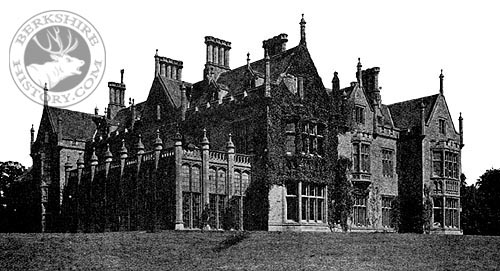 |
 |
|||
|
|
When the Crown held Beckett Manor at Shrivenham, in the early 13th century, it is recorded that King John stayed there and sent letters from the property. The Beckett family probably had a medieval hall house on the estate in the 14th century. The medieval lady buried under her effigy in the parish church, may be one of their wives. In the following century, it was owned by the Shottesbrookes and their heirs, the Rogers and the Essexes. The house was a secondary home, but the families were still often there. Sir William Essex may have built a Tudor mansion at Beckett, but he preferred Lambourn Place. He was the local MP during Henry VIII's reign, when he got caught up with a group of gentlemen critical of the Government's religious reforms. He took a copy of the demands of the Pilgrimage of Grace rebels back to Beckett House, which was OK, until his steward, Geoffrey Gunter, started making copies and passing it round the clergy of Reading. In the end, Sir William thrown in prison, if briefly. In 1633, Beckett was sold to the Admiralty judge, Sir Henry Marten, but it was his son, Henry Marten the Regicide, who made the house notorious during the Civil War. He was a republican in the extreme and didn't like Cromwell any better than the King. During the Second Civil War, he raised an unofficial cavalry regiment of levellers with the intention of opposing Parliament should they recall the Monarchy. They would meet at Beckett before rampaging round the local countryside, stealing horses from, not only travellers, but also Marten's neighbours. The house is said to have been considerably damaged by marauding Royalists during the War and, by the time Marten sold up to his friend and fellow leveller, Sir John Wildman, in 1657 (NOT Sir George Pratt in 1652), there was but half of it left standing. Unfortunately, the rest of the building burnt down nine years later. However, the so-called 'China House,' by the lake, survives from this period. It is a pagoda-like gazebo with a balcony for fishermen, attributed to Inigo Jones, and one of the oldest pieces of garden architecture in the country. John Wildman or his son of the same name presumably erected a replacement house. An arch from this building may have remained until 1952 as part of the kitchen block. Wildman Junior had no heir and adopted the most honourable man he knew, in the Roman manner. His name was John Shute and Wildman hardly knew him. Later, he also inherited the estates of his cousin's husband, Francis Barrington, but he had to take on the his surname in order to get his hands on them. He was made Viscount Barrington in 1720. The present Beckett House (sometimes called Beckett Hall), was built slightly further south in 1831, by Thomas Liddell for his brother-in-law, the 6th Viscount, in a Tudor-Gothic revival style. The funds had been provided by Shute Barrington, the Bishop of Durham. The Barrngtons only quit the place in 1936. Beckett House is now at the centre of the Defence Acadamy of the United Kingdom, part of Cranfield University.
|
|||
| © Nash Ford Publishing 2010. All Rights Reserved. This location is now administered by Oxfordshire County Council. | ||||



 Beckett House
Beckett House